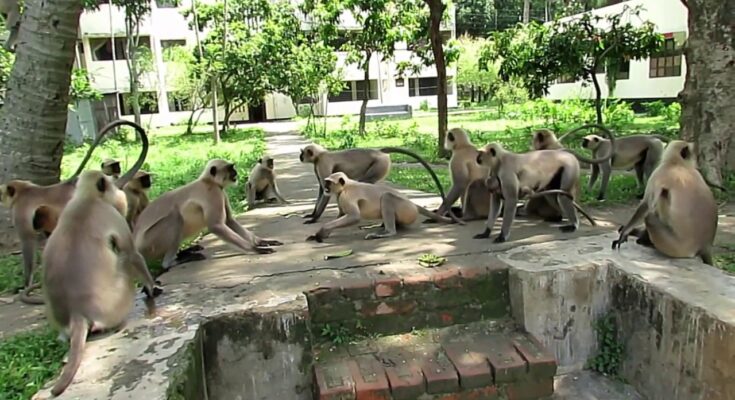Monkeys are fascinating creatures, exhibiting a wide range of behaviors that captivate the interest of both scientists and laypeople. Among the various species of monkeys, langurs stand out due to their complex social structures and distinctive vocalizations. Langur monkeys, primarily found in South Asia, are known for their aggressive interactions with rival groups. These interactions, often marked by intense fights and a cacophony of sounds, offer a window into the intricate world of primate behavior.
Social Structure and Territory
Langur monkeys, particularly the Hanuman langur (Semnopithecus entellus), are highly social animals living in groups called troops. These troops typically consist of one dominant male, several females, and their offspring. The social structure is hierarchical, with the dominant male having breeding rights and control over the group. This structure is crucial for maintaining order within the troop and ensuring the protection of resources and territories.
Territory plays a vital role in the lives of langur monkeys. Troops establish and defend their territories vigorously, as these areas provide essential resources such as food, water, and shelter. The boundaries of these territories are often contested, leading to frequent confrontations between neighboring groups. These territorial disputes can escalate into intense battles, marked by both physical combat and vocal displays.
The Nature of Langur Monkey Fights
Fights between langur troops are complex and multifaceted. When a rival group encroaches on their territory, the dominant male and sometimes other members of the troop will engage in aggressive displays to ward off the intruders. These displays include charging, chasing, and physical altercations. The goal is to establish dominance and force the rival group to retreat.
During these confrontations, physical violence is not uncommon. Males will bite, scratch, and grapple with each other, often inflicting serious injuries. The intensity of these fights can vary, ranging from brief skirmishes to prolonged battles. The outcome of these encounters can significantly impact the social dynamics within the troops involved. Victorious males may gain access to new territories and mating opportunities, while defeated males may be ousted from their groups and forced to live solitary lives until they can establish dominance elsewhere.
Vocalizations: The Language of Conflict
One of the most fascinating aspects of langur monkey fights is the role of vocalizations. Langurs are highly vocal animals, using a variety of sounds to communicate with each other. These vocalizations play a crucial role during conflicts, serving as both warnings and signals to other members of the troop.
The sounds produced by langurs during fights are diverse and can convey different messages. Loud, resonant calls are often used to assert dominance and intimidate rivals. These calls can be heard over long distances, warning other troops to stay away. Screeches and grunts are common during physical confrontations, expressing aggression and distress. Each type of vocalization has a specific purpose, helping to coordinate the actions of the troop and increase the chances of a successful defense or attack.
Researchers have studied these vocalizations extensively, uncovering a rich tapestry of communication strategies. For instance, the dominant male’s calls can rally the troop and boost their morale, while distress calls from injured members can elicit assistance from others. This intricate system of communication highlights the cognitive abilities of langurs and their capacity for social organization.
Implications for Understanding Primate Behavior
Studying langur monkey fights and their vocalizations provides valuable insights into the broader field of primate behavior. These interactions reveal the importance of social structure, territoriality, and communication in the lives of primates. By observing how langurs manage conflicts and maintain group cohesion, researchers can draw parallels to the behaviors of other primate species, including humans.
Moreover, understanding the dynamics of langur monkey fights can aid in conservation efforts. As human activities increasingly encroach on the natural habitats of langurs, conflicts between troops may become more frequent and intense. By recognizing the factors that drive these conflicts, conservationists can develop strategies to mitigate human-wildlife interactions and protect these fascinating creatures.
In conclusion, the study of langur monkey fights and their vocalizations offers a compelling glimpse into the complex social lives of these primates. These interactions, marked by aggressive displays and a rich array of sounds, underscore the importance of territory, dominance, and communication in the animal kingdom. As we continue to explore the behaviors of langurs and other primates, we gain a deeper appreciation for the intricacies of nature and the evolutionary forces that shape the lives of these remarkable animals.



